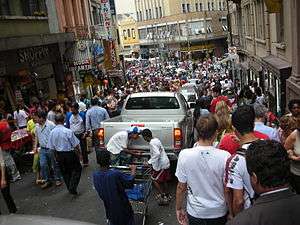Rua 25 de Março
 | |
|---|---|
| Rua 25 de Março | |
|
Rua 25 de Março from above | |
| Former name(s) | Rua de Baixo |
| Location | Centro, São Paulo |
| Postal code | 01021-000, 01021-100, 01021-200 |
| Nearest metro station | São Bento |
| Coordinates | 23°32′39″S 46°37′57″W / 23.54429°S 46.63261°WCoordinates: 23°32′39″S 46°37′57″W / 23.54429°S 46.63261°W |
| South end | Avenida Rangel Pestana |
| North end | Rua Paula Souza |
| Construction | |
| Inauguration | 1865 |
| Other | |
| Known for | Variety stores, wholesale retailers, counterfeit consumer goods, crowds |
| Website | 25 de março Já |
Rua 25 de Março or Rua Vinte e Cinco de Março (in English: March 25th Street) is a popular shopping street in the central zone of São Paulo, Brazil. The district surrounding Rua 25 de Março has long been synonymous in Brazil with large crowds and discount shopping.
History
Much of the area that is Rua 25 de Março today was originally part of the Tamanduateí River. A series of river engineering projects in the late nineteenth and earlier twentieth centuries realigned the Tamanduateí and Anhangabaú rivers, moving the river and the port further to the east. The old port, Porto Geral, lends its name to one of the major cross streets of 25 de Março, Ladeira Porto Geral. The original street name, “Rua de Baixo”, refers to the low (baixo) position of the land in comparison with the streets uphill to the west. In 1865 the name change was changed to commemorate the date of Brazil’s first constitution, signed on 25 March 1824.[1]
circa 1894 by Antonio Ferrigno
Waves of Middle Eastern immigrants arrived at the port and settled in the area during the latter half of the nineteenth century. In 1887 Lebanese immigrant Benjamin Jafet opened the first store on Rua 25 de Março. Other merchants began opening their own shops and the area grew. During the 1960s the area suffered with frequent flooding, which damaged the merchandise. The resulting necessity to sell large quantities of inventory quickly and at deep discounts established Rua 25 de Março’s reputation as a center for wholesale pricing.[1]
By the 1980s other immigrant communities from Korea, China, Greece, and Portugal began to open up shops on 25 de Março and neighboring streets. The commercial activity in the area had expanded to include more than wholesale shops by the end of the twentieth century.[1]
Present day
The area between the São Bento Monastery and the Municipal Market along Ladeira Porto Geral, as well as the street itself and other smaller side streets is commonly referred to by locals as Rua 25 de Março.
There are three main shopping malls in the area: The Shopping 25 de Março (25th of March Mall), Shopping Oriental (Oriental Mall) and the most famous Galeria Pagé (Pagé Gallery) and at the streets you can find a lot of stores with a miscellaneous kind of products, including tennis shoes, toys, packaging, jewelry, bags, and stationery. Most of these stores sells only in bulk and low prices, so many stores owners from far districts or other cities come to this place to buy goods for resale. Also end user consumer can buy goods, but at higher prices.
Crime
Brazil taxes on electronics are high, but these items can be found on 25 de Março for relatively low prices. However, the area has been subject to raids by the police for tax irregularities and counterfeit goods.

In November 2007, Law Kin Chong, a Chinese naturalized Brazilian and owner of 25 March Shopping, was arrested by the Brazilian Federal Police.[2]
Every year, Federal Police and Brazilian Customs make arrests in the 25 de Março area, especially the Galeria Page and Shopping 25 de Março. They confiscate smuggled or unauthorized products and close the stores who are selling these products. In 2011 the last operation took 2 weeks and started in April, 2011. One month after, the stores were opened and working again, selling cheap smuggled goods.

Though physical injuries and serious crimes and fatalities are very rare in the area, it is a haven for crooks stealing from unwary shoppers. Apart from many of the goods being stolen to begin with, 25 de Março is not a place to bring your Visa. Pickpockets are numerous, and it would be quite unusual for a person not to attempt to pickpocket a visitor, even if they don't succeed.
A person who shops here also runs the risk of getting caught by the government, though the dangers are quite low unless it is a foreigner bringing illegal goods back into their developed country, such as illegal electronics and software like Microsoft Windows, among other things.
Though most car traffic is now not allowed on the street during busy periods (photo above was taken before the rule was put in place), it is generally not a good idea to attempt to drive in the area. The reasons may be numerous, and an example can be seen in the photo placed on this page.
References
- 1 2 3 "História da 25 de março". 25demarcoja.com.br (in Portuguese). Retrieved 15 March 2015.
- ↑ França, Valeria (25 March 2010). "Livro revela 145 anos de história da 25 de Março". estadao.com.br (in Portuguese). O Estadão de São Paulo. Retrieved 15 March 2015.
.jpg)